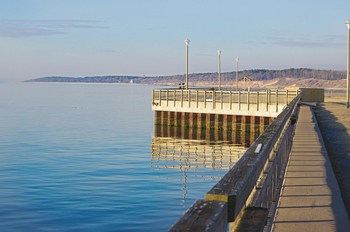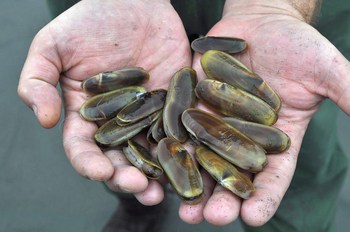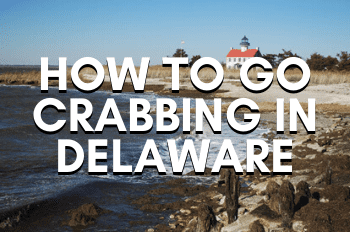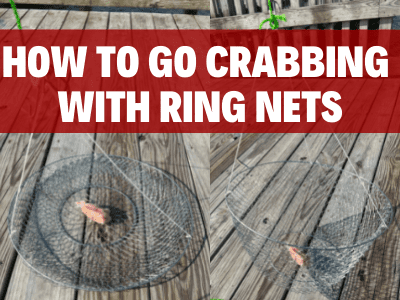How to Catch Blue Crabs With a String (Handlines Guide)
The other day I went crabbing with handlines, also known as the chicken and string method, to see if blue crabs are running in Delaware in May 2022. If you’re wondering, no, they are not running yet. Regardless, I got some great photos of the process and I want to show them here in this quick and easy guide.

First, we will go over what you will need to go crabbing with handlines. When you have everything we need, we’ll talk about finding the right time and place. Last, we’ll go over the technique of using handlines.
Table of Contents
Where to go Crabbing with Handlines
Materials
Gather a dip net, some string, bait, and something to hold your crabs.

Looking at the image above, you can see that I’ve gathered:
- A handline (Any normal string will also work in a weak current).
- A piece of chicken as bait.
- A long-handled dip net.
- A piece of driftwood to act as an anchor (optional).
Let’s go over each item as each one is as important as the next when it comes to this crabbing technique.
Handline (What I’m using)

You may remember that I mentioned any string tied to some bait will work to catch blue crabs. This is only partly true. If the current is too strong, your bait will be dragged with it. If this is the case, there is also a good chance that your bait will be swept away with it.
To prevent this, I recommend you purchase a handline (also called a throwline). I took a picture of two lines I’m using. The one on the left is from the previous season (you can see the discolorment) while the one on the left is brand new. I bought the brand new one for $3.00 at Walmart, but I found a bulk amount on Amazon. Click here to check the current price of this item on Amazon.com (Affiliate Link).
The main benefits to using this pre-made handline are the built-in bait clip and weight. Like I said earlier, a string with some bait will be too light and dragged around in the current. With a weight, your bait will stay in one place. We will talk about why that’s important when I’m actually discussing the technique later in this article.
The bait clip allows you to clip any sort of bait to the handline. If you do end up using plain old string, it’s likely that your bait will fall off your string.
You will need several handlines to make crabbing worthwhile. I’ve found that 4 lines per person are a manageable amount.
Bait
The most common bait you’ll hear of is chicken, which will work as well as any bait. If you would like to read about what baits you can use to go crabbing, read my article: What’s The Best Bait For Crabbing?.
If you’re using normal string instead of a hand line, use bait that has a bone in it. For example, a chicken neck or chicken leg will have a bone you can tie our string to. If you tie your string to a flimsy, boneless piece of bait, it’ll rip away in the current. Anyone who’s done this will tell you that your bait will start to fall apart in the water.
If you use one of the handlines I recommended above, use any piece of chicken you’d like. This includes boneless chicken and other boneless baits (fish fillets, etc.). It comes with a built-in bait clip to secure your bait.
Dip Net
A dip net is a bag-shaped net on the end of a handle. This is what we are going to use to scoop crabs from the water. If you already own one then you are all set, but if you need to buy one I recommend you consider the length of the handle.
Depending on the spot where you’re crabbing, it may be useful to have a longer-handled dip net. If your handlines are set from a dock, for example, you will need a longer net to reach the water. If you’re wading in the water like I am today, you can get away with a shorter handle. Just keep in mind that you will need some distance from the crabs so you can scoop them fast enough.

I recommend you take the thinking out of it and just buy a dip net with an adjustable length. That way you can adjust it for whichever crabbing spot you pick. Click this link or the image above to see this product on Amazon.com (Affiliate Link).
Something to hold your crabs
When it comes to storing crabs, you have several options. Bring a cooler you don’t mind smelling like crabs, a bushel basket, a bucket, the list goes on! I have a whole article dedicated to this topic, so I recommend you read: How to Keep Blue Crabs Alive and Well.
Also, bring what you need for a day on the water!
Crabbing is just half the battle! Being fair-skinned myself, I never go crabbing without sunscreen. Bring a comfy folding chair, a cooler with drinks and snacks, and bug spray. Don’t forget the bug spray! I talk about all of this in my article: Here are 20 Things You Should Bring on a Crabbing Trip.
Location
Find a shallow, calm shoreline of tidal or brackish water.
Blue crabs live in saltwater and brackish water. Expect to find blue crabs in any type of water other than freshwater. This means that the further inland you go (further away from the ocean), you will find fewer and fewer blue crabs.
This doesn’t mean that you should set up shop on the beach! Blue crabs love tidal marshes. Why wouldn’t they! They are full of algae and other plants that blue crabs eat. Today, I used handlines on the Indian River Bay at Holt’s Landing State Park, DE.

To summarize, find a sandy-bottomed, calm-watered shoreline with salt or brackish water. You want a spot where the water is not fast-moving on a fair-weathered day. I’ve done a great deal of research to find crabbing spots in every coastal state in the USA. To find a crab-filled shoreline near you, check out my crabbing spot index.
The best time to go crabbing with handlines is during the summer, or when the water temperature rises above 70 degrees Fahrenheit. For more information on the best time to go crabbing, check out my article: When is the Best Time to go Crabbing?
The Technique
As of now, I’m assuming that you have everything you need and found a spot to use your handlines. Now you are ready to actually go crabbing!
Step 1: Unwind your string or handline for at least 10 feet of line.
If you are using the handline I recommended from Amazon, start by unwinding it from the bait clip. You don’t want any string still raveled around it to avoid getting tangled. This will give you enough string to cast the bait into the water. If you’re not using a pre-made handline and you’re just using string, unwind at least 10 feet of line.
Now, whether you’re using a handline or just string, I want you to tie the end opposite to the bait clip to a long stick, piece of driftwood, or PVC pipe. This will be your anchor to keep your handline in place. With this, no crab can run off with your bait. Trust me, they will try!

Step 2: Add your choice of bait to the end of your string or bait clip.
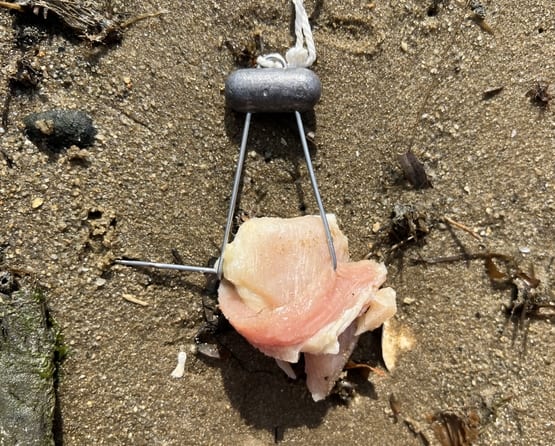
I added some fresh raw chicken breast to my bait clip to lure blue crabs to my handline. Bait clips are why I love to use pre-made handlines because I don’t have to worry about my bait falling off. If you end up just using string, you will need a piece of bait that has a bone in it (such as chicken necks or legs).
Another great bait I love to use is raw fish. I recommend you bring your fishing rod with you to catch bait for your handlines. Nothing beats fresh fish caught from the same water you are crabbing in.
Step 3: Throw the baited handline into knee-deep water.

Now you want to take your baited hand line and its anchor to the water. Wade in until the water gets as deep as the head of your dip net (plus a little wiggle room). There, you want to place your anchor and toss your baited line into the deeper water. See the image above for reference.
If you’re crabbing from a ledge or dock, you don’t need to wade in the water at all. The whole point of this is to make sure you’re crabbing in deep enough water and to lure crabs from all directions. If your line is set out in the water, you lure crabs from all directions, while if you set your line from the shore, you lose out on potential area coverage.
Step 4: Wait at least 5 minutes or until the string is pulled taut.
You will spend most of your time crabbing on this step: waiting for the blue crabs. Eventually, a crab is going to come along and try to take your bait with it. You may see your string start to tighten as it scurries away with your food.
Sometimes this may just look like the current dragging your bait, so VERY slowly pull it towards you to see if this is the case. If you feel resistance or tugging, you know you have a crab on the line. This takes practice, and you’ll know the feeling once you do this a few times.
Step 5: Slowly inch the string toward you with your dip net ready.
This is the hardest step to figure out. When I say inch the bait towards you, I mean very slowly pull the line. I use a hand over hand technique, pulling one inch at a time. The goal is to lure the crab on the bait towards you without it realizing its being pulled.
Everyone has their own technique, but I use the hand over hand technique. It’s a slow process, but the patient crabber gets the catch. You absolutely do not want to jerk the line or pull too fast. The crab will realize something’s up and run off.

One thing you want to in the meantime is have your dip net ready. If it’s just you in the water, tuck it under your arm as you pull the line towards you. If possible, find a friend who will take over this part (step 6).
Step 6: Scoop up any crab that’s eating the bait with your dip net.
Once you get it close enough, it’s time to strike! With one hand still on the line, take the other to grab the dip net. It may be easier to have a friend nearby to do this part. You then need to scoop the crab out of the water with your net.
This can be tricky because blue crabs are quicker than you think. One trick I found is to have the head of the net in the water before you try and scoop. This way is much easier than scooping the crab from above the water, as they won’t see it coming. If the net is already in the water and you pull it up from under the crab, you’re more likely to catch it.
Please research your state’s crabbing regulations before crabbing!
To project the blue crab populaiton, each state has regulations on what size crab you can keep, when you can go crabbing, and so forth. It’s the angler’s responsibility to know their state’s regulations while they are crabbing. A quick Google Search “Delaware crabbing regulations” will take you to the state’s DNR website with more information.
Handlines vs Other Crabbing Methods
Crabbing with handlines is the most hands-on way of catching blue crabs. If you want a more passive way of catching crabs, you would want to use a crab pot (also known as a crab trap or cage in the south). This is the only method that catches crabs without you actively pulling the trap. Collapsible traps (also known as foldable traps) are a little more passive by doing the work of both baiting and securing the crabs. You just need to be there actively pulling the traps.
If you want to read more about different crabbing methods for blue crabs, check out our crabbing method index. You can also pick from the buttons below:
The reason why you may want to choose handlines over others is for three reasons: the activity, your given location, and cost.
If you want a challenge or have some kids to entertain, you might as well try handlines. From personal experience, it’s difficult at first but once you get the hang of the technique it becomes an art. I would recommend collapsible traps if you want to entertain younger children, as the string method takes concentration.
As we went over earlier, this method is perfect for calm and shallow shorelines. If you are situated on a boat or pier, this method may not be for you. You need to be able to easily scoop crabs out of the water and be in a stationary position. If you’re in a moving boat or high above the water, this method will simply not work. So if you find yourself at a shoreline and want to catch crabs, handlines will be your best bet.
The last selling point of handlines is their simplicity and low cost. All you need is some string, bait, and a net. This is much cheaper than buying actual crab traps. If you just want to try out crabbing without spending a lot of money, just get some string and go for it.


